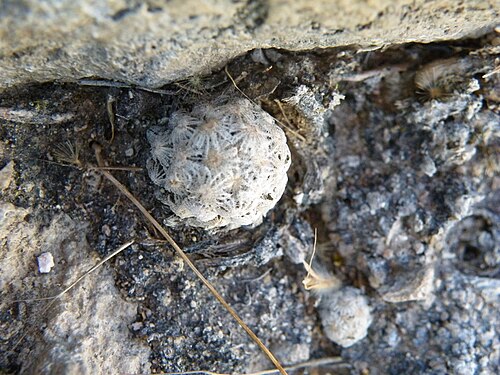| Cochemiea theresae | |
|---|---|

| |
| Conservation status | |
 Critically Endangered (IUCN 3.1) | |
| Scientific classification | |
| Kingdom: | Plantae |
| Clade: | Tracheophytes |
| Clade: | Angiosperms |
| Clade: | Eudicots |
| Order: | Caryophyllales |
| Family: | Cactaceae |
| Subfamily: | Cactoideae |
| Genus: | Cochemiea |
| Species: | C. theresae |
| Binomial name | |
| Cochemiea theresae (Cutak) Doweld | |
| Synonyms | |
| |
Cochemiea theresae is a species of cactus in the subfamily Cactoideae.
Description
Cochemiea theresae typically grows solitary with minimal branching. The spherical to cylindrical, olive-green shoots reach 4 centimeters in height and 1 to 3 centimeters in diameter, tapering into a strong taproot. The sparsely woolly axillae are between cylindrical warts. It lacks a central spine, but has 22 to 30 translucent white to yellowish-white radial spines, each up to 2 millimeters long.
The purplish flowers are funnel-shaped, 3.5 to 4.5 centimeters long, and 3 centimeters in diameter. The club-shaped fruits are embedded in the plant body and grow up to 10 millimeters long, containing black seeds. The seeds are released at the death of the plant after the disintegration of the old stem.
Distribution
Cochemiea theresae is found in the Mexicanstates of Durango and Zacatecas growing in moss patches over limestone rock formations and in grassland with nearby pine-oak forest.
Taxonomy
Cochemiea theresae is found in northwest Mexico, in Durango, and was discovered in 1966 by American Therese Bock near Conetop Pass at 2,100 to 2,500 meters altitude. Originally described as Mammillaria theresae by Ladislaus Cutak in 1967, the species honors Therese Bock, who discovered it. Alexander Borissovitch Doweld reclassified it into the genus Cochemiea in 2000.
References
- SG), Succulent Plants; Biología, Héctor Hernández (Instituto de (2009-11-18). "The IUCN Red List of Threatened Species". IUCN Red List of Threatened Species. Retrieved 2024-06-12.
- Anderson, Edward F.; Eggli, Urs (2005). Das grosse Kakteen-Lexikon (in German). Stuttgart (Hohenheim): Ulmer. p. 412. ISBN 3-8001-4573-1.
- B., Andrea (2013-08-04). "Cochemiea theresae". LLIFLE. Retrieved 2024-06-12.
 This article incorporates text from this source, which is available under the CC BY-SA 3.0 license.
This article incorporates text from this source, which is available under the CC BY-SA 3.0 license.
- "Cactus and Succulent Journal Nov-Dec 1967: Vol 39 Iss 6 : Free Download, Borrow, and Streaming : Internet Archive". Internet Archive. 2023-03-25. Retrieved 2024-06-12.
External links
 Media related to Cochemiea theresae at Wikimedia Commons
Media related to Cochemiea theresae at Wikimedia Commons Data related to Cochemiea theresae at Wikispecies
Data related to Cochemiea theresae at Wikispecies
| Taxon identifiers | |
|---|---|
| Cochemiea theresae | |
| Mammillaria theresae | |
This Cactaceae article is a stub. You can help Misplaced Pages by expanding it. |



